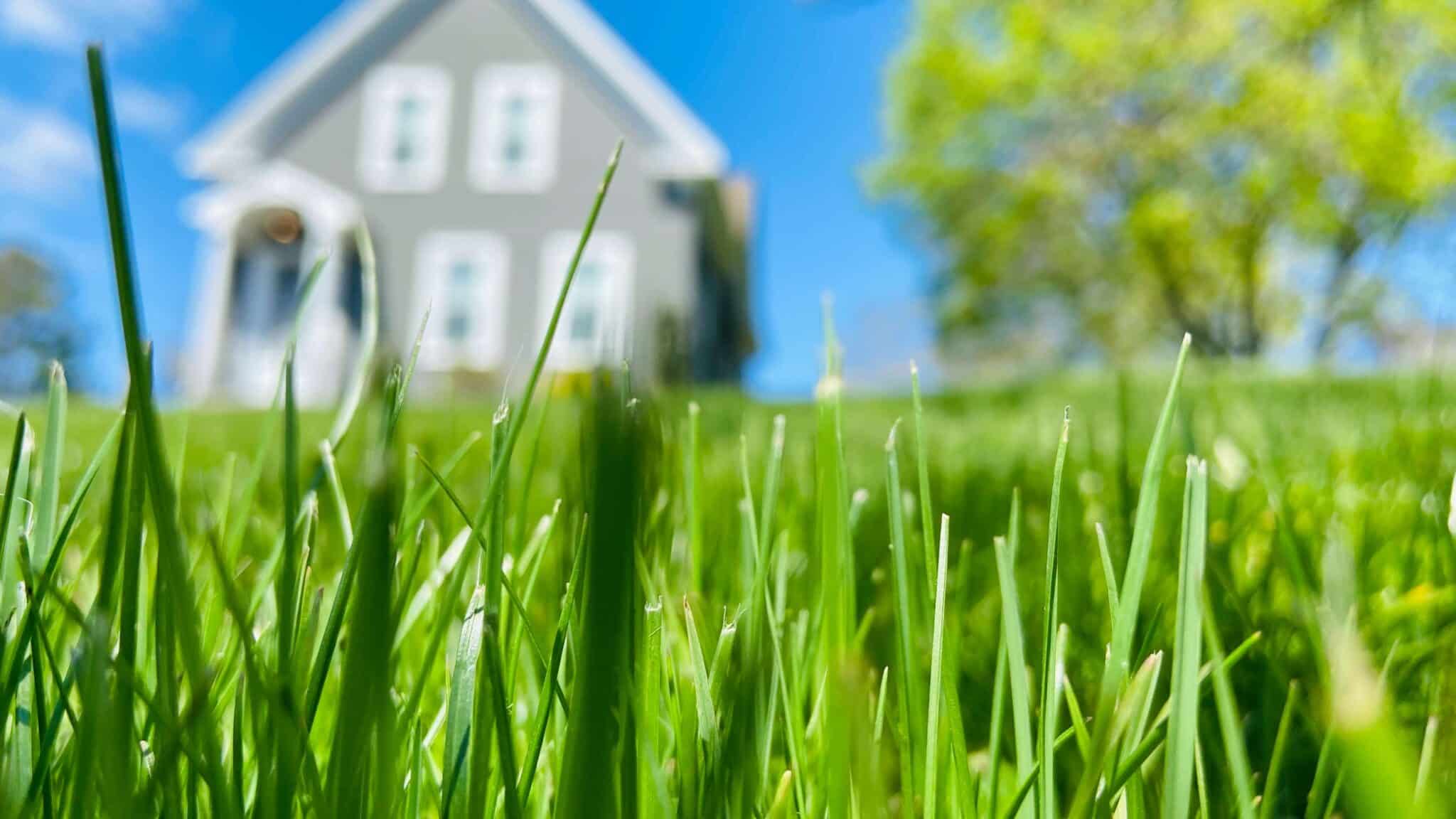Bahia Grass
When choosing the best grass for your lawn, there are many options out there.
Factors such as the type of coverage it provides, the maintenance required, its shade tolerance and climate should contribute to your decision. Learn more about Bahia Grass here to see if it’s the right choice for your lawn needs.

Some Facts About Bahia
Technically, this grass is Paspalum notatum and is from the Poaceae family. But you probably won’t be hearing it referred to it by this name very often. Some much more common names for this grass are:
- Common Bahia
- Bahiagrass
- Pensacola Bahia
Although it is often referred to as Pensacola Grass, this grass type is actually native to Mexico as well as South America. It is through the process of naturalization that Bahia grass has shown up in North America and other regions.
This type of grass is generally used as forage. Yet it can be very helpful when used as an erosion-controlling stabilizer for areas with soil issues.
Bahia Grass is a popular choice because it isn’t prone to many diseases or insect damage, which are commonly associated with warm season grasses.
Characteristics & Traits
To begin with, Bahia grass is a perennial grass best suited for tropical or subtropical climates. What it is best known for however, is its unique “V” shape.
This V consists of two spiky racemes that each break down into more, smaller spikes. Each spikelet also contains a small flower. From this flower, feathery black stigmas and stamens can be spotted hanging from the flower ends.
- Some of the other things to know about the look of this grass include:
It is well known for creating a dense sod due to its root system and growth patterns. - The average height of the stems range quite a bit. They can be as short as 20 cm up to approximately 75 cm.
- The overall look is distinct, and once you see Bahia Grass it is easy to identify.
Flowering Time
Typically, the time of year for Bahia Grass to flower is from June to November. Although, as long as this grass is subjected to the proper climate, it can flower at various times of the year depending on its location.
In the United States, summer is the perfect time for Bahia Grass to become ripe. Yet, at no time are all of the seeds matured.
One thing to keep in mind is that the pollen of this grass contains approximately four proteins that may cause allergic reactions. This can be important to know for families with members who are more prone to allergic reactions.
The leaves of paspalum notatum are flat and “hairless.” The leaves of this grass are also known for having a tough texture and tapering to a fine point.
Bases of the leaves are close to a purple color.
Bahia grass is referred to as a low growing “creeper” grass.
Where Did It Come From & What Are The Varieties?
So how exactly did Bahia Grass end up in the United States?
In 1914, this grass type was introduced from Brazil. It was introduced into the southeastern area of the United States as a pasture grass for sandy soil conditions that make it hard to grow anything. Since first being introduced in the U.S., other variations of the Bahia Grass have been developed.
This gives you some idea of what makes it a popular choice for certain climates and soil conditions. It is known for being low maintenance and does not require much water or fertilizer. One negative trait to keep in mind about this grass choice is that it is not well-known for being very visually pleasing.
There are three main types of Bahia grass in the United States:
Pensacola
Obvious from its name, this grass was chosen specifically for Pensacola, Florida starting around 1935. This is actually the most widely used variety in all of the United States today. Due to its extensive root system, it does the best with stress and potential threats. This variety of Bahia Grass can withstand both hot and cold temperatures.
Common
Course in texture and light in color, common Bahia Grass is not tolerant of cold weather. It is rarely a good choice for a lawn grass.
Argentine
Argentine is a darker green color and has dense sod. This is probably the best choice for a wider variety of lawn situations. It does well with cold temperatures and holds up well against disease and insects.
Advantages & Disadvantages
Before making a choice for which type of grass they want to use for their lawn, people should always be aware of the advantages as well as the potential disadvantages. Here is an overview of some points for both sides.
Advantages
- Deep root system
- Low maintenance
- Better able to adapt to sandy or infertile soil conditions
- Does not require much watering or fertilizing
- Ideal for landscapes lacking an irrigation system
- Prefers acidic soil
- Does not form dense thatch
- Can be grown from either seed or already established sod
- Reseeds itself
- Has few problems when it comes to potential concerns such as insects or disease
pen
Disadvantages
- Does not look as good as other types of grasses
- Requires regular mowing to prevent tall growth
- Can take a toll on the blades of a lawn mower rather quickly and cause the need for more regular blade sharpening and mower maintenance
- Does not do well in soil with a high-pH, such as those found in coastal regions
- Is susceptible to the mole cricket
- Does not do well with traffic, shade or saltwater
- Can be subject to weeds
- Does best in situations with exposure to full sun
- Is not as comfortable for cushioning for recreational activities as several other grass options
Establishment & Maintenance
As previously mentioned, Bahia grass can be established from either seed or sod.
As with any type of grass, there are advantages to establishing this choice from sod. For one thing the grass can establish and grow quicker when started from sod. There is also a lower chance for issues caused by weeds.
Many people prefer to start from seeds because it costs less and can be less time and labor intensive. Keep in mind though, if choosing seeds, the growth time is slow and it will take much longer to establish the lawn using this method.
Although Bahia grass does not require much water once established, this is not true during germination. Irrigation or regular watering is important to help strengthen and establish the root system. You may also opt for chemically enhanced seeds that germinate more quickly and lead to faster growth. Plugging and sprigging is not the recommended choice for Bahia because this leaves open areas for weeds to form.
In warmer climates like Florida, the ideal time to establish this grass is spring to early summer. This helps the grass get established before intense summer heat and before cooler fall and winter temperatures when growth is slow. Bahia Grass can be started at almost any time of year, but growth may be slower.
It is always a good idea to start preparing your yard prior to seeding or laying sod. Once sod is laid out, it is important not to mow it until the roots have had a chance to become established. A good general rule is to delay mowing your yard before the initial two to three week period has passed.
Although fertilization is not required once the lawn is established, it can be helpful. This will help to not only strengthen the grass and help it grow faster, but reduce the likelihood of damage from insects, disease, weeds or other potential threats. Before fertilizing your yard it is important to familiarize yourself with the guidelines and regulations of your state.
Where you live will also dictate the best time for fertilization. Other factors affecting the fertilization method for your newly established Bahia Grass include:
- The amount of shade
- Your soil test results
- Clipping management
- Personal preferences
- relating to low to high input grasses
- Length of time of establishment (i.e., new versus a few years older)
Areas with higher pH levels can cause Bahia Grass to suffer an iron deficiency and begin to yellow. This can be balanced out by adding an iron source. However, yellowing can also be caused by nitrogen deficiencies in Bahia Grass. It is a good idea to try to determine the cause for the discoloration before making fertilization choices.
Watering, Mowing & Pest Management
Because Bahia grass is often grown in climates that stay warm year round, it may require mowing year round. Generally, this grass should be mowed every one to two weeks during times with active growth. The height should be three to four inches, but keep in mind the more often you mow, the deeper and more extensive the system for roots.
This will help make the grass stronger and less susceptible to stress. Clippings from grass cuttings should be left on the ground. This helps to produce nutrients and cut down on the amount of fertilization needed.
Once well established, Bahia grass does not require much watering unless drought-like conditions occur. Bahia Grass does fairly well in drought conditions, but without water the grass will still begin to brown and will not grow.
You may need to consider irrigation or watering once you notice:
- Footprints leave remaining visible mark
- Folding and wilting occur
- The grass turns blue-grey or brown with cross
One of the advantages of Bahia Grass is that it does recover quickly from drought conditions once watered. This means that even following severe drought conditions this grass can quickly recover when rain or irrigation return. In fact it is more important to be careful of overwatering and causing weakened turf and weed growth.
When it comes to pest management, Bahia grass is less susceptible than many other types of grass. However, pests and problems certainly can occur.
Weeds are one of the most common problems that affect Bahia Grass. Weeds can often be dealt with by simply keeping the lawn healthy so the turf doesn’t allow weed growth.
The most common insect that impacts Bahia Grass is the mole cricket. These burrowing insects can cause a great amount of damage to the root system. You can spot the tunnels or apply a water and detergent mixture to the damaged turf and these pests will show themselves.
As far as diseases, there are very few that harm Bahia Grass. Dollar spot is the most common and is easily visible from a distance. Light nitrogen application usually takes care of this quickly.
It is crucial to make the best choices when dealing with grass stresses based on the type of grass you have, so that you do not cause damage to the lawn. Choosing the right grass for your yard is about more than the final look.







